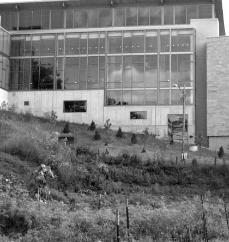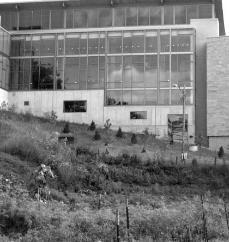
The Warch Campus Center is currently being evaluated for Gold LEED certification. Photo by Stacy Day (day, stacy)
Lawrence has scored a grade of
C on the 2010 Green Report Card,
a system used by the Sustainable
Endowments Institute to grade colleges
on their level of sustainability.
The newest results were released
Oct. 10.
The Sustainable Endowments
Institute collects its information
from four separate surveys: campus
operations, dining services, endowment
investment practices and student
involvement. These surveys
are sent to 332 schools across the
United States and Canada.
The Green Report Card takes
into account a variety of factors:
Green Building, Climate Change &
Energy, Transportation, Endowment
Transparency, Shareholder
Engagement, Administration,
Student Involvement, Food &
Recycling, and Investment Priorities.
Out of these, Lawrence
received the best grades in Food &
Recycling, Student Involvement and
Transportation. Lawrence received
the worst grades for Green Building,
Endowment Transparency, and
Shareholder Engagement.
Green Building
Jeff Clark, associate professor
of geology and faculty associate to
the president for Green Roots, did
not expect the poor Green Building
score, a D, saying he “would be
surprised if they didn’t revisit that
score.” The Warch Campus Center,
built to LEED Gold standards “should
have done it,” he said.
The campus center is still awaiting
certification, but, Clark noted,
“Other schools with the same situation
scored substantially higher.”
Though the campus center is the
only building Lawrence has submitted
for LEED certification, there are
many other buildings on campus
that could meet LEED standards.
Hiett Hall, for example, was built to
LEED standards when it was completed
in 2002.
Additionally, Youngchild,
Science Hall and Briggs Hall have
all gone under renovations within
the last 10 years to make them
greener, including timed lighting and
low-flow fixtures. Older buildings,
too, have been retrofitted with more
energy-efficient insulation, new windows
and fluorescent light bulbs.
LEED certification often costs
tens of thousands of dollars, something
that Lawrence takes into consideration
in trying to balance sustainability
and visibility, especially
when operating within the small
budget of a small school.
“We still have a lot to do with
conservation first,” said Clark, adding
that conservation would be a
more efficient use of the resources
that Lawrence does have. “We need
to do what works best for us right
now.”
Climate Change & Energy
Lawrence was given a C for
Climate Change & Energy, another
category in which a larger endowment
could have played a beneficial
role. A significant portion of
questions for this category regarded
school-generated renewable electricity.Lawrence did not and perhaps could not budget for solar panels or windmills. St. Olaf, for example, spent $1.9 million on a wind-powered turbine in 2006. Solar panels too can cost thousands of dollars, and both often supply only an inconsequential percent of the school’s total energy.
Clark said that these largely visibility-based investments can offer educational opportunities, but he summarizes them as mostly “cool but ineffective.”
Lawrence’s biggest climate change effort since last year’s Green Report Card is the new HVAC resolution. All Lawrence buildings’ temperatures will be regulated at 68 degrees now. This, as well as most of the renovation and retrofitting efforts of the last year, is an effort that might not make it to Green Report Card results until next year.
Transportation
Lawrence scored a B in Transportation, another category in which Clark expects improvement on the 2011 Green Report Card, again due to the time lapse between the implementation and results of new initiatives.
New initiatives include the use of the Toyota Prius for the admissions and development departments, the shuttle system to Alexander Gym, and the use of E85, an ethanol-based fuel, to power a portion of Lawrence’s motor fleet.
Additionally, the new bike-sharing program is expected to positively influence next year’s results.
Clark explained that transportation is a complicated category; answering the survey accurately involves taking into account every shuttle that travels to Alexander Gym and every trip a faculty member takes to a conference.
Endowment Transparency and Shareholder Engagement
On average, Endowment Transparency and Shareholder Engagement were the weakest categories nationally, and Lawrence was no different, earning two Fs in the report. This does not, however, necessarily reflect Lawrence’s competency in these areas; the endowment investment practices survey was never returned to the Sustainable Endowments Institute.
Brian Riste, vice president for business and operations, explained that Lawrence’s failure to complete this portion of the survey was due mostly to a lack of resources, though he does admit that Lawrence “should have found the time to complete the survey.”
Riste projected the Endowment Transparency grade as a D or F, likely as a result of the difficulty involved in balancing “transparency and shareholder engagement with the appropriate protection of our investment strategies.”
Clark does maintain, however, that the state of the university’s endowment is public, and likely viewable in the President’s Report.
Shareholder Engagement, a category that examines shareholder proxy voting procedures, was one that Riste imagined would probably have garnered a C or higher.
Administration
The Green Roots Initiative has been at the heart of the administration of sustainable efforts at Lawrence for the last year, addressing issues such as energy, transportation, food, grounds-keeping and water and paper use within its subcommittees.
Because Green Roots only remains a theme through the end of this year its budget will be reassigned at the year’s end.
Clark hopes that they are able to decide on a future for the group before then, whether it is set up as a permanent committee, an ad hoc position or a paid position.
President Beck also signed the Talloires Declaration this year, another large step in the administration category, and one that establishes “an institutional commitment to sustainability.”
Though Lawrence was awarded points for these initiatives, the university lacks any sort of permanent paid position concerned with sustainability. This is what likely dictated the C that Lawrence received for Administration.
Student Involvement
Lawrence received a B for student involvement. In this category, the Sustainable Endowments Institute cited the student groups SLUG, Greenfire, and the LUCC Environmental Responsibility Committee, all of which made the effort toward the HVAC policy.
This category showed one of the greatest improvements from the 2009 results, a D, and was the one that Clark found the most exciting. “You’ve got to figure we started with very little. … We should be inspired by the progress we’ve had.”
Lawrence’s complete survey responses, as well as more grading criteria and a comparison with the 2009 Green Report Card, are available at http://greenreportcard.org.

The Warch Campus Center is currently being evaluated for Gold LEED certification. Photo by Stacy D
ay (day, stacy)
